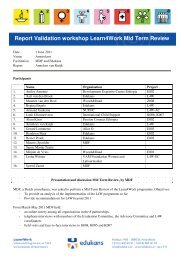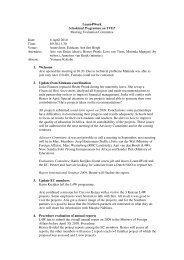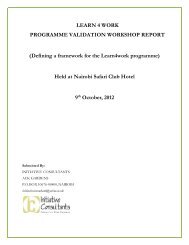Non â Formal TVET Mapping Survey Supported by Edukans ...
Non â Formal TVET Mapping Survey Supported by Edukans ...
Non â Formal TVET Mapping Survey Supported by Edukans ...
You also want an ePaper? Increase the reach of your titles
YUMPU automatically turns print PDFs into web optimized ePapers that Google loves.
<strong>Non</strong> – <strong>Formal</strong> <strong>TVET</strong> <strong>Mapping</strong> <strong>Survey</strong> The case of Amhara, Oromia and Addis Ababa<br />
Target<br />
Criteria<br />
Urban<br />
line<br />
Interested to be trained<br />
Interested to be self employed<br />
Orphans Children and youth<br />
With no income to support<br />
their livelihood<br />
Physically matured to be self<br />
employed<br />
Interested to be self employed<br />
<br />
<br />
<br />
Rural<br />
Landless<br />
Unemployed<br />
Physically matured to be<br />
self employed<br />
Interested to be self<br />
employed<br />
5. Training programs:<br />
Training programs need not necessarily be fixed. Institutions like CSTC have<br />
been giving training on specific trades like tailoring, woodwork, etc. Depending<br />
on the market need, training programs have to be flexible in duration, schedule<br />
and education requirements.<br />
The types of training trades are limited in number in contrast to the experiences of<br />
other countries. Trades that are relevant to the Ethiopian situation need to be<br />
studied and recommended.<br />
Most adults living in rural areas are illiterate and lack vocational training. They<br />
need relevant training that will make them self-employed and improve their<br />
livelihood.<br />
The unemployed youth also require trainings responsive to local market demand<br />
for self-employment or become semi skilled workers be it in their location or<br />
elsewhere.<br />
4. Curriculum:<br />
Training institutions need to develop their training manuals. In the absence of<br />
such materials continuity of training could be at stake whenever there is staff<br />
turnover. Training institution need to get technical support from the government<br />
and NGOs. Running training manual development workshops could help.<br />
5. Facilities<br />
Training equipment in NF<strong>TVET</strong> centers are too old and inadequate. Relevant<br />
training requires equipment that could serve market needs and training standards.<br />
Training institutions need land for constructing workshops, classrooms and<br />
organizing different types of services for trainees. This requires giving special<br />
consideration for NF<strong>TVET</strong> training institutions to provide them free land.<br />
Graduate trainees need to be organized in micro scale enterprises so that they can<br />
get loan and support in the effort they make in self-employment.<br />
Education Expertise Center Feb 2008 45







